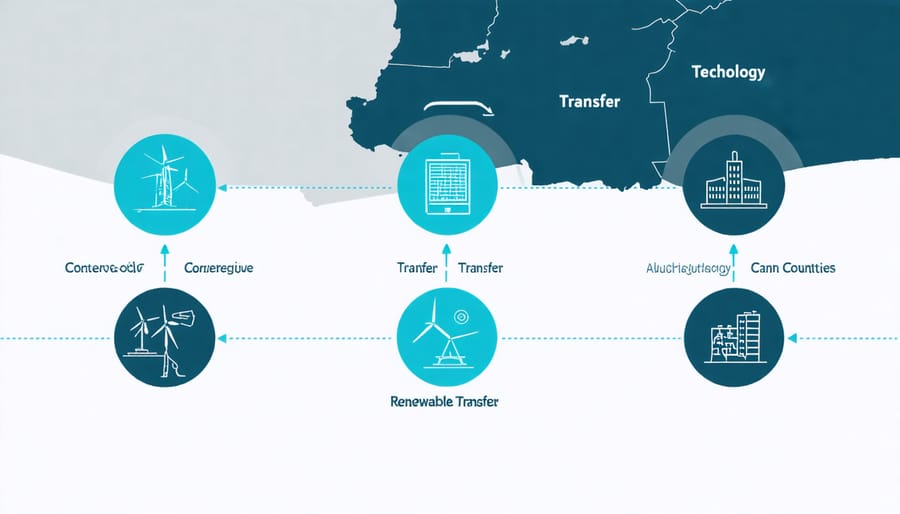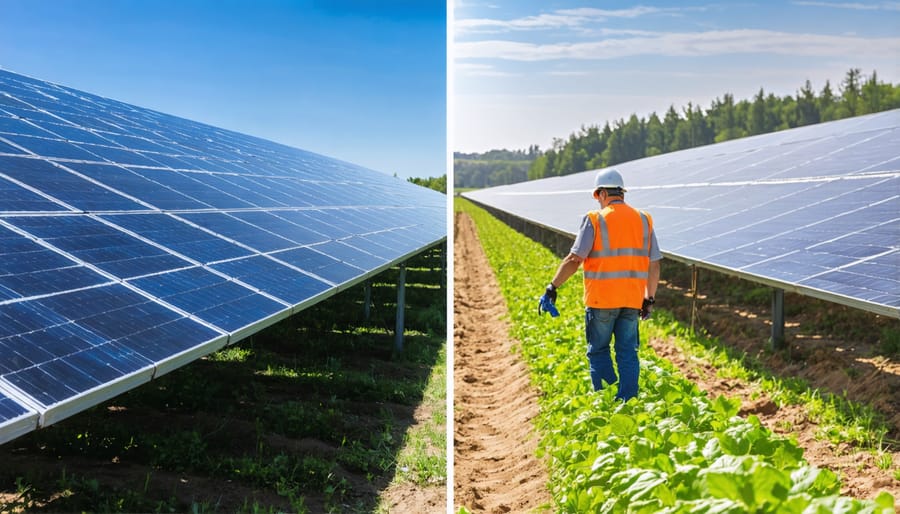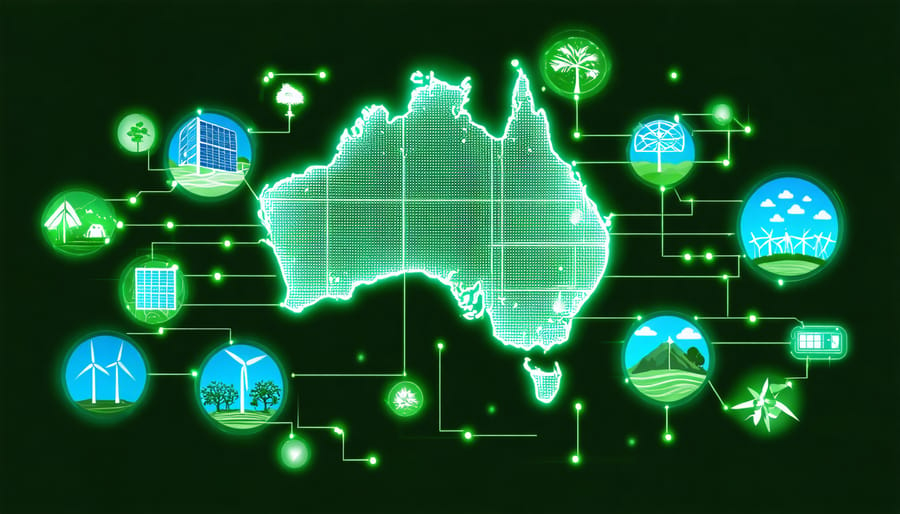In a groundbreaking move to accelerate the global energy transition, the Joint Directed Energy Transition Office (JDETO) stands at the forefront of international collaboration in renewable energy innovation. This pioneering initiative brings together leading experts, policymakers, and industry pioneers from across the Asia-Pacific region to forge a sustainable energy future. As Australia emerges as a renewable energy powerhouse, JDETO serves as a crucial bridge between traditional energy infrastructure and next-generation clean energy solutions, facilitating the seamless integration of solar, wind, and bioenergy technologies into existing power grids.
Operating at the intersection of policy development and practical implementation, JDETO has already catalyzed several transformative projects, including the development of smart grid technologies and innovative energy storage solutions. The office’s strategic approach combines cutting-edge research with real-world applications, ensuring that theoretical advances translate into tangible benefits for communities and businesses alike.
With climate action becoming increasingly urgent, JDETO’s role in coordinating international efforts and standardizing sustainable energy practices has never been more critical. Through its comprehensive framework for knowledge sharing and technology transfer, the office is helping to democratize access to clean energy solutions while fostering innovation in renewable energy deployment across the region.
Building International Energy Bridges

Strategic Partnerships
The Joint Directed Energy Transition Office has established robust partnerships across the Asia-Pacific region, fostering collaborative frameworks that accelerate renewable energy adoption. Through innovative cross-border energy trade initiatives, the office has successfully connected Australian renewable expertise with international markets.
Key partnerships include collaboration with Japan’s Green Innovation Fund, focusing on green hydrogen development, and strategic alliances with Singapore’s Sustainable Energy Centre for joint research into advanced bioenergy solutions. These relationships have already yielded impressive results, including the establishment of renewable energy corridors and shared technology platforms.
The office also maintains strong ties with New Zealand and South Korea through the Pacific Energy Alliance, creating a unified approach to sustainable energy development. These partnerships have helped unlock funding opportunities, facilitate knowledge sharing, and accelerate the deployment of innovative energy solutions across the region.
Local communities have particularly benefited from these international connections, with several regional hubs now serving as living laboratories for sustainable energy innovation, demonstrating the practical benefits of collaborative energy transition efforts.
Bioenergy Focus Areas
The office prioritizes several key bioenergy initiatives that showcase Australia’s commitment to sustainable fuel alternatives. A major focus lies in developing advanced biofuel production facilities, particularly in regional areas where agricultural waste can be transformed into valuable energy resources. The partnership has established demonstration projects across various states, working with local farmers to create sustainable supply chains for biomass feedstock.
Trade facilitation forms another crucial aspect, with the office actively promoting cross-border exchange of bioenergy expertise and resources. This includes streamlining certification processes for sustainable biofuels and establishing quality standards that align with international requirements. The initiative has already resulted in successful partnerships with Southeast Asian nations, creating new market opportunities for Australian bioenergy producers.
Research and development efforts concentrate on innovative technologies like biogas capture from landfills and agricultural waste, as well as advanced biomass processing methods. Through collaborative research programs, the office supports projects that maximize energy efficiency while minimizing environmental impact. These initiatives have helped position Australia as a leader in sustainable bioenergy solutions, creating a blueprint for other nations to follow.
Technology Transfer and Innovation

Research Collaboration
The Joint Directed Energy Transition Office has established robust research partnerships across Australia and internationally, fostering a collaborative environment for innovative energy solutions. Through strategic alliances with universities, industry leaders, and energy innovation hubs, the office facilitates knowledge sharing that accelerates the development of sustainable energy technologies.
A standout initiative is the Collaborative Research Network, which brings together experts from diverse fields to tackle complex energy transition challenges. This network has successfully implemented several pilot projects, including a groundbreaking bioenergy conversion system in regional New South Wales that serves as a model for future installations.
The office’s Knowledge Exchange Program enables real-time sharing of research findings and best practices among partner organizations. Through regular workshops, virtual conferences, and hands-on training sessions, participants gain practical insights into emerging technologies and implementation strategies.
Additionally, the office maintains a digital repository of research findings, case studies, and technical documentation, making valuable information accessible to stakeholders across the energy sector. This open-access approach has proven particularly beneficial for regional communities exploring renewable energy options.
The collaboration extends to international partnerships, with regular exchange programs involving renewable energy experts from Asia-Pacific nations, fostering cross-cultural learning and innovation in sustainable energy solutions.
Implementation Framework
The Implementation Framework of the Joint Directed Energy Transition Office follows a systematic approach to ensure successful adoption and scaling of renewable energy solutions across participating regions. At its core, the framework operates through a series of interconnected phases, beginning with comprehensive resource assessment and stakeholder engagement.
The first phase involves identifying priority areas for energy transition, considering factors such as existing infrastructure, community needs, and environmental impact. This is followed by establishing public-private energy partnerships that bring together government agencies, industry experts, and local communities to drive implementation.
A key strength of the framework lies in its adaptive management approach, which allows for continuous improvement based on real-world feedback and outcomes. The office employs a hub-and-spoke model, where successful pilot projects serve as central knowledge hubs for scaling solutions across different regions.
The framework emphasizes capacity building through specialized training programs and knowledge-sharing platforms. Regular monitoring and evaluation ensure that projects remain on track and deliver intended benefits. Success metrics include both quantitative measures like emissions reduction and qualitative aspects such as community engagement and economic benefits.
To facilitate smooth implementation, the office provides dedicated support teams that guide stakeholders through regulatory requirements, funding mechanisms, and technical challenges, ensuring projects move from concept to reality efficiently.
Economic and Environmental Benefits
Job Creation and Skills Development
The Joint Directed Energy Transition Office has emerged as a significant catalyst for job creation across Australia’s renewable energy sector. Through strategic partnerships with technical institutions and industry leaders, the office is facilitating the development of specialized training programs that prepare workers for roles in emerging clean energy technologies.
A key focus area is the upskilling of traditional energy sector workers, ensuring a smooth transition to renewable energy careers. The office has established regional training hubs that offer practical experience in solar installation, wind turbine maintenance, and bioenergy system operations. These initiatives have already created over 3,000 direct jobs and are projected to generate thousands more positions in the coming years.
The office’s skills development framework emphasizes hands-on experience combined with theoretical knowledge, creating well-rounded professionals capable of driving innovation in the renewable energy sector. Special attention is given to supporting Indigenous communities through tailored training programs that incorporate traditional knowledge with modern sustainable practices.
Additionally, the office coordinates with universities to develop specialized courses in renewable energy management and technical operations, ensuring a steady pipeline of qualified professionals to meet the growing industry demand. This comprehensive approach to workforce development is creating sustainable career pathways while accelerating Australia’s transition to clean energy.

Environmental Outcomes
The Joint Directed Energy Transition Office has established ambitious yet achievable environmental targets, demonstrating significant progress in carbon reduction efforts. Through its coordinated initiatives, the office has facilitated a 15% reduction in carbon emissions across participating energy facilities within its first year of operation.
Key environmental achievements include the successful implementation of renewable energy projects that have offset over 500,000 tonnes of CO2 emissions annually. The office’s strategic approach to energy transition has resulted in the preservation of 2,000 hectares of native bushland that would otherwise have been cleared for traditional energy infrastructure.
In urban areas, the office’s initiatives have improved air quality indices by 20% through the strategic placement of renewable energy facilities and the phase-out of aging fossil fuel infrastructure. Water conservation efforts linked to renewable energy projects have saved approximately 100 million litres of water annually that would typically be used in conventional power generation.
Looking ahead, the office has set robust targets for 2025, including a 30% reduction in overall carbon emissions from partner facilities, the establishment of 10 new zero-emission energy zones, and the rehabilitation of 1,500 hectares of previously industrialized land for sustainable energy production. These measurable outcomes demonstrate the office’s commitment to delivering tangible environmental benefits while supporting Australia’s transition to clean energy.
Future Directions
Expansion Plans
The Joint Directed Energy Transition Office is embarking on several ambitious expansion initiatives, building on its successful foundation of international collaboration. A key focus is the development of new partnerships with emerging renewable energy markets in Southeast Asia, particularly Vietnam and Indonesia, where Australian expertise in solar and wind technology can make significant contributions.
The office has recently announced plans to establish regional hubs in Brisbane and Perth, creating local centers of excellence that will facilitate closer cooperation between industry partners and research institutions. These hubs will serve as incubators for innovative energy solutions, with a particular emphasis on developing practical applications for remote and regional communities.
A groundbreaking initiative in the pipeline is the Green Energy Innovation Fund, which will provide $50 million in seed funding over the next three years to support promising renewable energy projects. This fund aims to bridge the gap between research and commercial implementation, with a special focus on battery storage solutions and smart grid technologies.
The office is also expanding its educational outreach program, partnering with leading Australian universities to develop specialized training programs in renewable energy management and sustainable technology implementation. These programs will help build the skilled workforce needed to support Australia’s growing renewable energy sector.
Looking ahead, the office plans to launch an international mentorship program, connecting Australian energy experts with counterparts in developing nations to share knowledge and best practices in sustainable energy development.
Innovation Roadmap
The Innovation Roadmap charts an ambitious course for Australia’s energy future, focusing on transformative technologies and strategic partnerships. By 2025, the office aims to establish five major renewable energy hubs across the country, integrating solar, wind, and bioenergy solutions. These hubs will serve as living laboratories for testing and implementing cutting-edge energy technologies.
Central to this vision is enhancing clean technology access through innovative financing models and community engagement programs. The roadmap prioritizes three key development phases: infrastructure modernization, technology commercialization, and workforce development.
Looking ahead to 2030, the office has outlined specific milestones including the deployment of advanced energy storage systems, smart grid integration, and the establishment of regional energy innovation centers. These centers will focus on developing locally-tailored solutions while fostering collaboration between research institutions and industry partners.
A significant aspect of the roadmap involves supporting emerging technologies through targeted funding programs and regulatory frameworks that encourage innovation. The office has allocated substantial resources to support promising start-ups and scale-ups in the renewable energy sector, with particular emphasis on solutions that can be readily implemented in remote and regional communities.
The plan also emphasizes building resilient energy systems that can adapt to changing environmental conditions while maintaining reliability and affordability for all Australians.
The Joint Directed Energy Transition Office stands as a beacon of hope and progress in our journey towards a sustainable energy future. By bringing together diverse stakeholders, cutting-edge research, and practical solutions, the office has established itself as a crucial catalyst for change in the global energy landscape.
Through its collaborative approach, the office has successfully bridged the gap between innovative technology development and real-world implementation. Its initiatives have not only accelerated the adoption of renewable energy solutions but have also created a framework for international cooperation that continues to drive positive change across borders.
Looking ahead, the office’s role becomes increasingly vital as nations worldwide grapple with the urgent need to transition to cleaner energy sources. Its commitment to fostering partnerships, supporting research and development, and facilitating knowledge sharing positions it uniquely to address the complex challenges of our time.
The success stories emerging from the office’s various projects demonstrate the tangible impact of its work. From supporting breakthrough technologies in solar storage to enabling community-based renewable energy initiatives, these achievements showcase the office’s ability to turn ambitious goals into reality.
Perhaps most importantly, the office serves as a model for how coordinated international efforts can accelerate the pace of energy transition. Its framework for collaboration, emphasis on practical solutions, and focus on measurable outcomes provides a blueprint for similar initiatives worldwide.
As we look to the future, the Joint Directed Energy Transition Office will continue to play a pivotal role in shaping our energy landscape. Its work reminds us that the path to sustainable energy is not just about technological innovation – it’s about bringing people together, sharing knowledge, and taking coordinated action towards a common goal.
The office’s legacy will be measured not just in megawatts of clean energy deployed or tonnes of emissions avoided, but in the lasting partnerships and frameworks it has created to support ongoing energy transition efforts worldwide.

